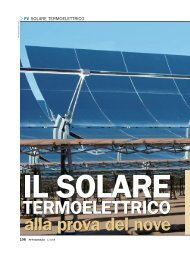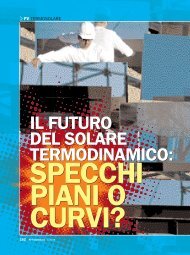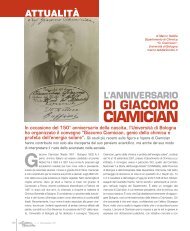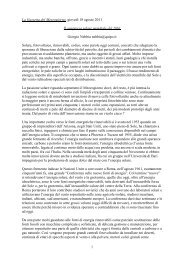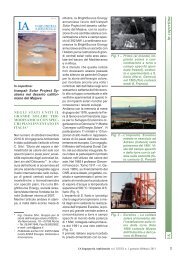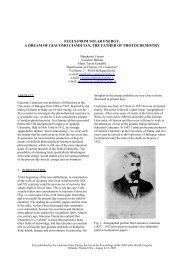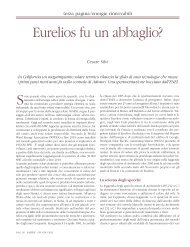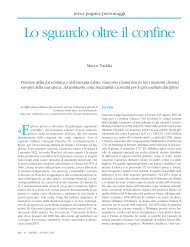The Pioneering Work On Linear Fresnel Reflector ... - GSES
The Pioneering Work On Linear Fresnel Reflector ... - GSES
The Pioneering Work On Linear Fresnel Reflector ... - GSES
You also want an ePaper? Increase the reach of your titles
YUMPU automatically turns print PDFs into web optimized ePapers that Google loves.
<strong>On</strong>e must not believe, despite the silence of modern writings, that the idea of using heat for mechanical<br />
operations is recent. <strong>On</strong> the contrary, one must recognize that this idea is very ancient and in its slow<br />
development across the centuries it has given birth to various curious devices.<br />
In 1878 Mouchot exhibited at the Universal Exposition in Paris what is commonly known to be the first and<br />
largest machine in the world to produce solar steam. Mouchot’s sun machine was subsequently improved by<br />
his assistant Abel Pifre, by adopting a spherical parabolic solar collector to power a printing press [1].<br />
Fig. 1. Left, Augustine Mouchot’s sun machine, the largest of its time, on display at the Universal<br />
Exposition in Paris in 1878. Right, Abel Pifre’s solar-powered printing press, exhibited at the Gardens<br />
of the Tuileries in Paris 1880 [1] [5].<br />
<strong>The</strong>se developments in France were noted in several other countries, especially in those lacking in coal and<br />
other fossil fuels. In Italy, Alessandro Battaglia (1842 – n.a.), an Italian engineer from Acqui Terme, thought<br />
that the Mouchot-Pifre designs, despite their merits, also had several inherent limitations that he illustrated in<br />
1884 at the Istituto di Incoraggiamento di Napoli (Encouragement Institute of Naples) [6].<br />
In his paper “Sul modo e sulla convenienza di utilizzare il calor solare per le macchine a vapore” (<strong>On</strong> the<br />
methods and convenience of using solar heat for steam engines) Battaglia illustrated the limitations of the<br />
Mouchot-Pifre designs:<br />
- It is not possible to build boilers of sufficient capacity to power industrial engines due to the fact<br />
that the boiler is mounted on the tracking collector, which limits its size;<br />
- <strong>The</strong> boiler loses its heat easily because it is exposed to open air and cannot be insulated and<br />
protected;<br />
- <strong>The</strong> tracking collector, as a single surface, is also limited in its total area.<br />
To overcome these limitations, Battaglia proposed separating the boiler from the collecting reflector area. He<br />
proposed a horizontal cylindrical boiler 30 meters in length and 1 meter in diameter, enclosed inside an<br />
insulating brick oven with a window of the same length as the boiler and 1 meter in height, facing a separate<br />
collecting reflector area made up of 1250 small flat mirrors, one square meter each, distributed in 42 rows of<br />
30 mirrors each. <strong>The</strong> system, which he described in economic and technical details, was estimated to have an<br />
output of 50 HP (37.3 kW), with an approximate cost of 100,000 lire in 1884 or 420,233 in 2008 Euros.<br />
In 1884, Battaglia applied for a patent for his invention as a “Collettore multiplo solare” (Multiple Solar<br />
Collector), though with a boiler of just 10 meters and only 250 of the 1250 flat mirrors indicated in his paper.<br />
Battaglia’s patent is illustrated in the following drawings in figure 2, courtesy of the Central State Archive,<br />
Rome, Italy.<br />
<strong>The</strong> purpose of Battaglia’s invention, as explained in his patent, is “to collect the solar rays that strike a<br />
specific portion of the earth’s surface at any latitude, and to reflect them, concentrated in a specially shaped<br />
beam, onto a specific surface of limited size, in order to obtain a high temperature and a quantity of calories<br />
capable of causing a specific effect, at a cost relatively small for the size of the reflecting surface. <strong>The</strong><br />
surfaces that receive and reflect the solar rays are metallic, silver-coated and burnished. <strong>The</strong> reflection must<br />
be continuous; that is, it must be aimed at the same point every day of the year, from sunrise to sunset [7].”






